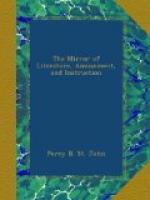At the Reformation, its chantries were dissolved, and the order of priests expelled about the year 1536. In 1542, Lee, then Archbishop of York, granted, by indenture to the king, the manor of Southwell. In the thirty-fourth year of his reign, Henry VIII., by act of parliament, declared Southwell the head and mother church of the town and county of Nottingham, and soon afterwards re-founded and re-endowed it, probably at the instance of Cranmer, at that time in the height of favour, who was a native of Nottinghamshire, not far from Southwell. Soon after the accession of Edward VI. the chapter was again dissolved, and its prebendal, and other estates granted to John, Earl of Warwick, afterwards made Duke of Northumberland; by him they were sold to John Beaumont, Master of the Rolls, and coming soon afterwards to the crown, by escheat, were granted to the favourite Northumberland, who retained them until his attainder in 1553, when they again reverted to the crown; and by Queen Mary were restored to the Archbishop of York, in as ample manner as they had before been holden. It appears from the Registrum Album, a register of the church, that in the latter end of the reign of William I. there were at least ten prebends. In the office of augmentation, an estimate of Southwell College, in the first of Edward VI. states King Edgar to have been the founder of the church, which consisted of sixteen prebends, and sixteen vicars. There are now sixteen prebends, of which the Archbishop of York is sole patron, a vicar-general appointed out of the prebendaries by the chapter, six vicars, and six choristers. Alfric, appointed to the See of York in 1023, gave two large bells to the church of Southwell (William of Malmsbury.) This was about the time of bells coming generally into use. King Stephen granted that the canons of Southwell should hold the woods of their prebends, in their own hands, which succeeding monarchs, Henry II. Richard, John, and Henry III. confirmed. There are two fellowships, and two scholarships, founded in St. John’s College, Cambridge, by Dr. Keton, canon of Sarum, twenty-second Henry VI. to be presented by the master, fellows, and scholars of that college, to persons having served as choristers in the chapter of Southwell. In the civil wars nearly all the records of Southwell Church were destroyed, the Registrum Album escaping, which contains grants of most of




